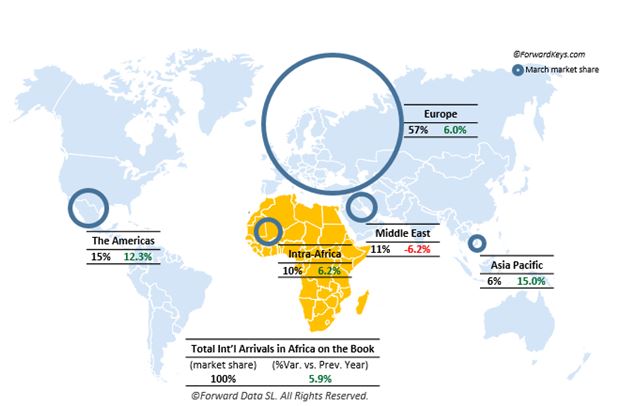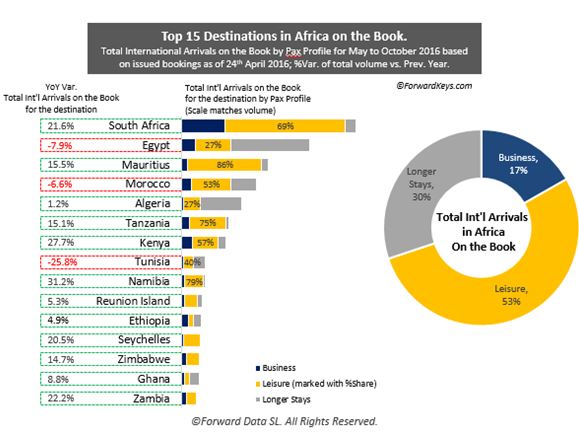NAIROBI, Kenya, May 6 – International flight bookings to Kenya have gone up by 27 percent for the summer season compared to this time last year according to the latest data from ForwardKeys, a travel analytics organization that analyses 14 million reservation transactions each day.
The data states that bookings made for the beginning of May onwards show that nearly all the top African destinations are seeing an increase in international arrivals by almost 6 percent.
Namibia tops the list, up 31.2 percent on the previous year, with Kenya in second place, up 27.7 percent, followed by South Africa, up 21.6 percent.
The increase in forward bookings from May to October compared with 2015, with robust growth in arrivals from across the globe as well as from within the continent.
Only three of the top 15 destinations in Africa are showing fewer advance bookings – Egypt down 7.9 percent, Morocco down 6.6 percent and Tunisia down 25.8 percent.
“It’s clear that recent events have impacted travel to North African countries, especially Egypt, Morocco and Tunisia which are all showing a marked decline in tourism numbers. However, the picture in Sub-Saharan Africa has changed, with most countries showing very positive increases, such as Namibia, up 31.2%, Kenya up 27.7% and South Africa up 21.6%,” said Olivier Jager, CEO, ForwardKeys.
Johannesburg still heads the list for scheduled international air capacity to airports in Africa but Addis Ababa is a close second. ForwardKeys data shows planned total seats to Addis enjoying an increase of 22 percent for the 2016 summer season.
The data shows forward bookings from Europe – which at 57 percent has the biggest market share – are up 6.0 percent. Significantly, travel within Africa is also increasing and at a faster rate, up 6.2 percent.
The Americas, with a market share of 15 percent, are up 12.3 percent.
Overall, the majority – 53 percent – of intercontinental visitors are travelling for leisure purposes with business accounting for 17 percent.
The ForwardKeys data has been produced in partnership with AviaDev Africa, a route planning and development conference being launched by Bench Events in Kigali, Rwanda.
The October event is being run in parallel with the high-profile Africa Hotel Investment Forum and will, for the first time, bring together airlines, airports, government representatives and tourism authorities to discuss the future connectivity of the continent.
The total number of seats for flights from Europe to Africa, between May and October, has dropped 7.3%. The fall is due to Europe suspending regular and charter flights to Tunisia and Egypt. UK capacity to Tunisia dropped 91% and Russian capacity to Egypt was down 97%, reflecting recent terror-related incidents.
Kenya’s tourism sector is yet to make a full recovery despite the government’s calculated efforts to take it back to its former glory.
Last year, for instance, international arrivals were down to 1.18 million from the previous year’s 1.35 million marking a 12.6 percent decline.
Tourism earnings dipped to Sh84.6 billion from Sh87.1 billion in 2014, according to the Kenya National Bureau of Statistics (KNBS) in its latest edition of the Economic Survey.
The bureau attributes security concerns, particularly at the coastal region, and the negative travel advisories from some European source markets to have been the crux of the matter.
“Both visitor arrivals and tourism earnings have been on a downward trend since 2011. This was mainly attributed to security concerns associated with terrorism activities,” says the 2016 Economic Survey.
But that’s not all; the aftermath of the Ebola Outbreak in West Africa in 2014 was noted to have slowed international visitor arrivals in the country last year.
Even the visit by US President Barack Obama during the Global Entrepreneurship Summit last July, the Papal Visit and the 10th WTO Ministerial Conference did not bump up the numbers as was expected.
The government, however, ran to the sector’s rescue with an increased budgetary allocation to the ministry from Sh5.6 billion in 2014/2015 to Sh10.7 billion in 2015/2016.
“The funds were used to market Kenya as a preferred tourism destination. The government also created a stand-alone Ministry of Tourism, which is intended to focus more on issues that directly affect the sector.”
The cash injection, however, did not stop bed occupancy and the number of visitors to national parks and game reserves from going down.
Broken down, bed occupancy by residents of Europe went down by 23.6 percent.
“The highest decline was registered for residents of Italy from 156,200 in 2014 to 74,100 in 2015.”
The coastal beach also noted to have dropped occupancy from 2.52 million to 2.11 million in 2015. Bed-nights occupied in Nairobi high-class hotels were also noted to have dropped.





































